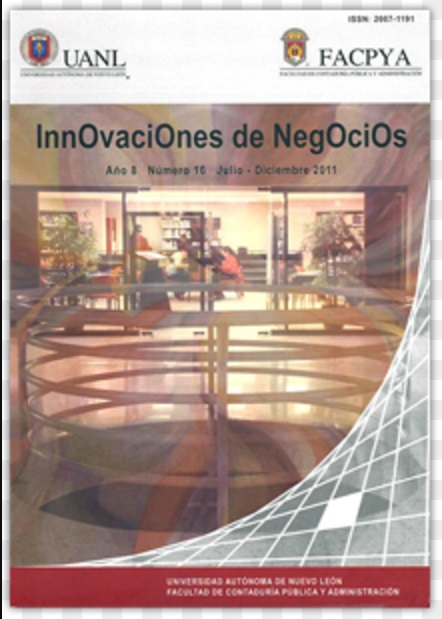La selección de alternativas asimétricamente dominadas: Una réplica del efecto de atracción en un contexto culturalmente diferente
DOI:
https://doi.org/10.29105/rinn8.16-2Palabras clave:
Alternativas Asimétricamente Dominadas, Comportamiento para Evitar Conflictos, Efecto de Atracción, Emociones NegativasResumen
Los conflictos en la toma de decisiones del consumidor surgen cuando los atributos del producto están correlacionados negativamente, y los consumidores perciben que las alternativas tienen diferentes ventajas y desventajas. Los consumidores recurren a diferentes comportamientos para evitar conflictos que les permitan atenuar las emociones negativas que, frecuentemente, están conectadas con esos conflictos. En esta investigación se prueba el efecto de atracción en un área del norte de México. Los resultados muestran que, a pesar de las diferencias culturales entre México y Estados Unidos, el efecto de atracción se presenta en una muestra de estudiantes mexicanos. Sin embargo, mientras que el efecto de atracción ocurre en la selección entre opciones de productos, no ocurre en un diseño que se basa en asignar puntos a las diferentes opciones. Estos resultados se consideran en el contexto de investigaciones previas sobre consumidores que prefieren evitar la toma de decisiones, y se sugieren posibles explicaciones para los resultados.
Descargas
Citas
Bhargava, M., J. Kim, & R. K. Srivastava (2000). Explaining Context Effects on Choice Using a Model of Comparative Judgment. Journal of Consumer Psychology. 9: 167-177.
Bettman, J. R., E. J. Johnson, M. F. Luce, & J. W. Payne (1993). Correlation, Conflict, and Choice. Journal of Experimental Psychology: Learning, Memory and Cognition. 19:931-951.
Bettman, J.R., M. F. Luce & J. W. Payne (1998). Constructive Consumer Choice Processes. Journal of Consumer Research. 25: 187-217.
Dhar, R. (1996). The Effect of Decision Strategy on Deciding to Defer Choice. Journal of Behavioral Decision Making. 9: 265-281.
Dhar, R. & S. M. Nowlis (2004). To Buy or Not to Buy: Response Mode Effects on Consumer Choice. Journal of Marketing Research. 41: 423-432.
Dhar, R. & S. J. Sherman (2000). Trying Hard or Hardly Trying: An Analysis of Context Effects in Choice. Journal of Consumer Psychology. 9: 189-200.
Doyle, J. R., D. J. O’Connor, G. M. Reynolds, & P. A. Bottomley (1999). The Robustness of the Asymmetrically Dominated Effect: Buying Frames, Phantom Alternatives, and In-Store Purchases. Psychology & Marketing. 16: 225-243.
Einhorn, H. J. & R. M. Hogarth (1981). Behavioral Decision Theory: Processes of Judgment and Choice. Annual Review of Psychology. 32: 53-88.
Evanschitzky, H., C. Baumgarth, R. Hubbard & J. S. Armstrong (2007). Replication Research’s Disturbing Trend. Journal of Business Research. 60: 411-415.
Hansen, D. E. & J. J. Helgeson (2001). Consumer Response to Decision Conflict From Negatively Correlated Attributes: Down the Primrose Path or Up Against the Wall? Journal of Consumer Psychology. 10: 159-169.
Hedgcock, W. & A. R. Rao (2009). Trade-Off Aversion as an Explanation for the Attraction Effect: A Functional Magnetic Resonance Imaging Study. Journal of Marketing Research. 46: 1-13.
Houston, D. A. & Kelly D. (1996). Comparison of Paired Choice Alternatives and Choice Conflict. Applied Cognitive Psychology. 10: 125-135.
Hubbard, R. & D. E. Vetter (1996). An Empirical Comparison of Published Replication Research in Accounting, Economics, Finance, Management, and Marketing. Journal of Business Research. 35: 153-164.
Huber, J., J. W. Payne & C. Puto (1982). Adding Asymmetrically Dominated Alternatives: Violations of Regularity and the Similarity Hypothesis. Journal of Consumer Research. 9: 90-98.
Huber, J. & C. Puto (1983). Market Boundaries and Product Choice: Illustrating Attraction and Substitution Effects. Journal of Consumer Research. 10: 31-44.
Hunter, J. E. (2001). The Desperate Need for Replications. Journal of Consumer Research. 28: 149-158.
Khan, U., M. Zhu & A. Kalra (2011). When Trade-Offs Matter: The Effect of Choice Construal on Context Effects. Journal of Marketing Research. 48: 62-71.
Kiesler, C. A. (1966). Conflict and Number of Choice Alternatives. Psychological Reports. 18:603-10.
Luce, R. D. (1959). Individual Choice Behavior: A Theoretical Analysis. New York: Wiley. Luce, M. F. (1998). Choosing to Avoid: Coping with Negatively Emotion-Laden Consumer Decisions. Journal of Consumer Research. 24: 409-433.
Luce, M. F., J. R. Bettman & J. W. Payne (1997). Choice Processing in Emotionally Difficult Decisions. Journal of Experimental Psychology: Learning, Memory, and Cognition. 23: 384-405.
Luce, M. F., J: W. Payne & J. R. Bettman (1999). Emotional Trade-Off Difficulty and Choice. Journal of Marketing Research. 36: 143-159.
Malaviya, P. & K. Sivakumar (2002). The Influence of Choice Justification and Stimulus Meaningfulness on the Attraction Effect. Journal of Marketing Theory and Practice. 10 : 20-29.
Mishra, S., U. N. Umesh & D. E. Stem (1993). Antecedents of the Attraction Effect: An Information-Processing Approach. Journal of Marketing Research. 30: 331-349.
Oshikawa, S. (1969). Can Cognitive Dissonance Theory Explain Consumer Behavior? Journal of Marketing. 33: 44-49.
Prelec, D., B. Wernerfelt & F. Zettelmeyer (1997). The Role of Inference in Context Effects:Inferring What You Want from What Is Available. Journal of Consumer Research. 24: 118-125.
Ratneshwar, S., A. D. Shocker & D. W. Stewart (1987). Toward Understanding the Attraction Effect: The Implications of Product Stimulus Meaningfulness and Familiarity. Journal of Consumer Research. 13: 520-533.
Simonson, I. (1989). Choice Based on Reasons: The Case of Attraction and Compromise Effects. Journal of Consumer Research. 16: 158-74.
Straits, B. C. (1964). The Pursuit of the Dissonant Consumer. Journal of Marketing. 28: 62-66.
Thompson, B. (1994). The Pivotal Role of Replication in Psychological Research: Empirically Evaluating the Replicability of Sample Results. Journal of Personality. 62: 157-176.
Tversky, A. & E. Shafir (1992). Choice Under Conflict: The Dynamics of Deferred Decision. Psychological Science. 3: 358-361.
Tversky, A. & I. Simonson (1993). Context-Dependent Preferences. Management Science. 39: 1179-1189.
Descargas
Publicado
Cómo citar
Número
Sección
Licencia
Derechos de autor 2017 Innovaciones de Negocios

Esta obra está bajo una licencia internacional Creative Commons Atribución-NoComercial-CompartirIgual 4.0.
La revista InnOvaciOnes de NegOciOs es una revista electrónica gratuita y de acceso abierto de carácter científico-académico y es una publicación de la Universidad Autónoma de Nuevo León, en la cual los autores conservan sus derechos de autor y otorgan a la revista el derecho exclusivo de primera publicación del trabajo. Se permite que terceros utilicen el contenido publicado, siempre y cuando se reconozca la autoría del trabajo y se cite la primera publicación en esta revista.
Para mayor información favor de comunicar a la Secretaria de Investigación (FACPyA) de la Universidad Autónoma de Nuevo León. Teléfono: (81) 1340-4431. Correo electrónico: revinnova.negocios@uanl.mx










